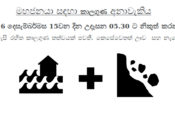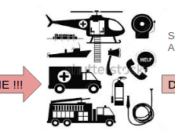Author: Nuwan Waidyanatha
-

Sri Lankan low-literate communities enjoy symbology in disaster communication
In general low-literate community members, in Sri Lanka, struggled with comprehending the Sri Lanka Meteorological Services text bulletins – that is what was observed. Simpler visual indicators are easier to digest and help them with deciding on the safety and response measures they need to activate. Our aim was to understand how low-literate (or functionally…
-

Cyber-attacks and Power-failure: Disrupters of ICT use in Warning Dissemination
We have been monitoring the accessibility of the Myanmar and Maldives SAMBRO servers. Our remote server, in Singapore, pings each of the servers every 10 minutes and logs whether the server was accessible over the Internet or not. Accessibility has been extremely poor in both countries over the past 20 days. We found out that…
-
Extending Early Warnings to Linguistically Marginalized Populations
In a work for the World Meteorological Organization, M. Golnaraghi [1] stated that “it is crucial that warning messages are clear, consistent and include risk information, designed with consideration for linking threat levels to emergency preparedness and response actions and understood by authorities and the population.” However, in its current state of practice, early warnings…
-
ITU Kaleiderscope best paper awarded to SAMBRO
We presented our paper on the “intricacies of implementing the ITU-T X.1303 recommended warning standard for cross-agency situational-awareness in Myanmar, Philippines, and Maldives at ITU Kaleiderscope (2016). It is an IEEE conference sponsored by the Telecommunication Standardization Bureau (TSB). The paper was not technical in the strict sense but discussed ICT policy relevant findings that…
-
Technology Stewardship, is it for the Sahana Habitat?
Last week, I was part of a Research Team that pilot tested a training course designed to build Technology Stewardship capacity in support of knowledge mobilization. The concept originates from Wenger, White, and Smith’s work on Communities of Practice, published in the Digital Habitat. From a Digital Habitat perspective the research team would be classified…
-
Maldives Launches “Dhandhaana” for Early Warning
Dhandhaana in Divehi means “Reach”. This is the name the Maldives National Disaster Management Center (NDMC) has given the Sahana Alerting and Messaging Broker (SAMBRO) implementation. Now SAMBRO powers NDMC to reach the communities at risk with alerts and warnings. The implementation was the a key outcome of the “CAP on a Map” project; funded…
-
SAMBRO Narrowing the Response Distance in the Maldives
Intricacies of Managing Island Emergencies Placing and maintaining emergency services in each Island, in the Maldives, can be costly for the Government. It does not make economic sense for the Government to place an air ambulatory service and a fire brigade in each Island. Some Islands have an inhabitant population of, less than, a 1000…
-
Philippines Simulations Evaluation Report and Recommendations
The Philippines Atmospheric Geophysical and Astronomical Services Administration (PAGASA) has implemented the Common Alerting Protocol (CAP) for Tropical Cyclone and Flood Public warnings. PAGASA has an official CAP feed that publishes the “public alerts”. The Sahana Alerting and Messaging Broker (SAMBRO) was implemented to complement and interlink the PAGASA CAP-enabled system to offer a visual…
-
SAMBRO a One-Stop-Shop for the Philippine Media to get Warnings
During the Press Conference, organized by the “CAP on a Map project” in Quezon City, the Philippine Media asked the question, “how would the new system help Philippines?” The new system the they were referring to was the Common Alerting Protocol (CAP) -enabled and Sahana Alerting and Messaging Broker (SAMBRO) technology. The answer was two…
-

Towards a Research Design: Pictographs in Disasters
The Research Team met at Microsoft Research India, in Bangalore, to formulate a practical and appropriate research design to test the hypothesis – “pictographs, designed for the linguistically challenged, can effectively communicate disaster information for saving lives and livelihoods.” In the context of disaster communication we have identified two key communication requirements, illustrated in the…
